Flexible Theoretical Calculation of Loop Length and Area Density of Weft-Knitted Structures: Part II
Abstract
:1. Introduction
2. Materials and Methods
3. Results and Discussion
3.1. Theoretical Calculation of Weft-Knitted Elements Length
3.2. Theoretical Calculation of Weft-Knitted Fabric Area Density
4. Conclusions
Author Contributions
Funding
Institutional Review Board Statement
Informed Consent Statement
Data Availability Statement
Acknowledgments
Conflicts of Interest
References
- Chen, Q.; Shou, D.; Zheng, R.; Tang, K.P.M.; Fu, B.; Zhang, X.; Ma, P. Moisture and Thermal Transport Properties of Different Polyester Warp-Knitted Spacer Fabric for Protective Application. Autex Res. J. 2021, 21, 182–191. [Google Scholar] [CrossRef]
- Muraliene, L.; Mikucioniene, D. Influence of structure and stretch on air permeability of compression knits. Int. J. Cloth. Sci. Technol. 2020, 32, 825–835. [Google Scholar] [CrossRef]
- Tvarijonaviciene, B.; Mikucioniene, D.; Ciukas, R. Influence of knitting process conditions and washing on tensile characteristics of knitted ribbon yarns. Fibres Text. East. Eur. 2005, 13, 74–77. [Google Scholar]
- Savci, S.; Curiskis, J.I.; Pailthorpe, M.T. A Study of the Deformation of Weft-knit Preforms for Advanced Composite Structures Part 1: Dry Preform Properties. Compos. Sci. Technol. 2000, 60, 1931–1942. [Google Scholar] [CrossRef]
- Arbataitis, E.; Mikucioniene, D.; Halavska, L. Flexible Theoretical Calculation of Loop Length and Area Density of Weft-Knitted Structures: Part I. Materials 2021, 14, 3059. [Google Scholar] [CrossRef] [PubMed]
- Mikucioniene, D.; Halavska, L.; Bobrova, S.; Ielina, T.; Milasius, R. Ultra-strong knits for personal protective equipment. Appl. Sci. 2020, 10, 6197. [Google Scholar] [CrossRef]
- Buzaite, V.; Repon, R.M.D.; Milasiene, D.; Mikucioniene, D. Development of multi-layered weft-knitted fabrics for thermal insulation. J. Ind. Text. 2021, 51, 246–257. [Google Scholar] [CrossRef]
- Wang, Q.M.; Hu, H. Geometrical and Dimensional Properties of Plain Knitted Fabrics Made from Glass Fiber Yarns for Composite Reinforcement. J. Ind. Text. 2007, 37, 139–148. [Google Scholar] [CrossRef]
- Pandita, S.D.; Falconet, D.; Verpoest, I. Impact Properties of Weft-knitted Fabric Reinforced Composites. Compos. Sci. Technol. 2002, 62, 1113–1123. [Google Scholar] [CrossRef]
- Berenguer, J.L.; Diaz-Garcia, P.; Martinez, P.M. Determining the loop length during knitting and dyeing processes. Text. Res. J. 2021, 91, 188–199. [Google Scholar] [CrossRef]
- Berenguer, J.L.; Martınez, P.M.; Dıaz-Garcıa, P. Modelling loop length in weft-knitted fabrics with an interlock structure after the dyeing process with a stitch density, wales and courses per centimetre analysis. J. Text. Inst. 2020, 111, 934–940. [Google Scholar] [CrossRef]
- Demiroz, A.; Dias, T. Part II: Experimental Studies and Computer Generation of Plain Knitted Structures. J. Textile Inst. 2000, 91, 481–492. [Google Scholar] [CrossRef]
- Kurbak, A.; Kayacan, O. Basic Studies for Modeling Complex Weft Knitted Fabric Structures Part V: Geometrical Modeling of Tuck Stitches. J. Text. Inst. 2008, 78, 577–582. [Google Scholar] [CrossRef]
- Čiukas, R. Design of Knits: Monograph; Technologija: Kaunas, Lithuania, 1996; p. 152. (In Lithuanian) [Google Scholar]
- Alpyidiz, T.; Kurbak, A. A Geometrical Model for the Single Pique (Lacoste) Knits. Text. Res. J. 2006, 76, 861–867. [Google Scholar] [CrossRef]
- Kurbak, A.; Alpyidiz, T. A Geometrical Model for the Double Lacoste Knits. J. Text. Inst. 2008, 78, 232–247. [Google Scholar] [CrossRef]
- Kurbak, A.; Alpyidiz, T. Geometrical Models for Cardigan Structures Part I: Full Cardigan. J. Text. Inst. 2009, 79, 1281–1300. [Google Scholar] [CrossRef]
- Kurbak, A.; Alpyidiz, T. Geometrical Models for Cardigan Structures Part II: Half Cardigan. J. Text. Inst. 2009, 79, 1635–1648. [Google Scholar] [CrossRef]
- Ciukas, R. Design of knitted fabrics. Fibres Text. East. Eur. 1997, 5, 37–39. [Google Scholar]
- Ciukas, R.; Sadauskas, D. Theoretical determination of area density and tightness factor for weft knitted fabrics. In Proceedings of the International Textile, Clothing and Design Conference, Dubrovnik, Croatia, 3–6 October 2004; pp. 669–674. [Google Scholar]
- Ciukas, R.; Tvarijonaviciene, B.; Mikucioniene, D. Estimating the linear density of ribbon-type yarns and the structure indices of fabrics knitted from them. Fibres Text. East. Eur. 2006, 14, 41–43. [Google Scholar]

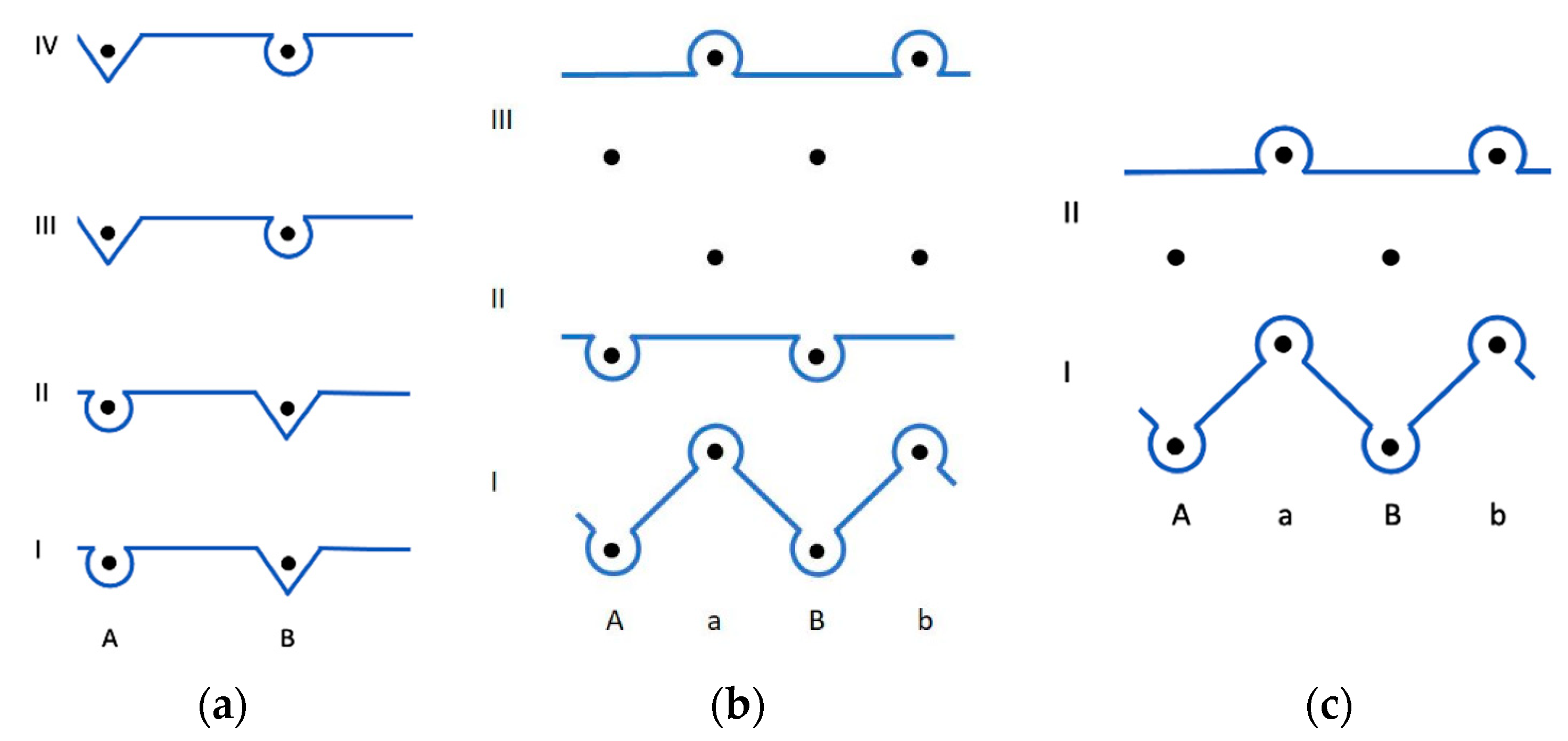
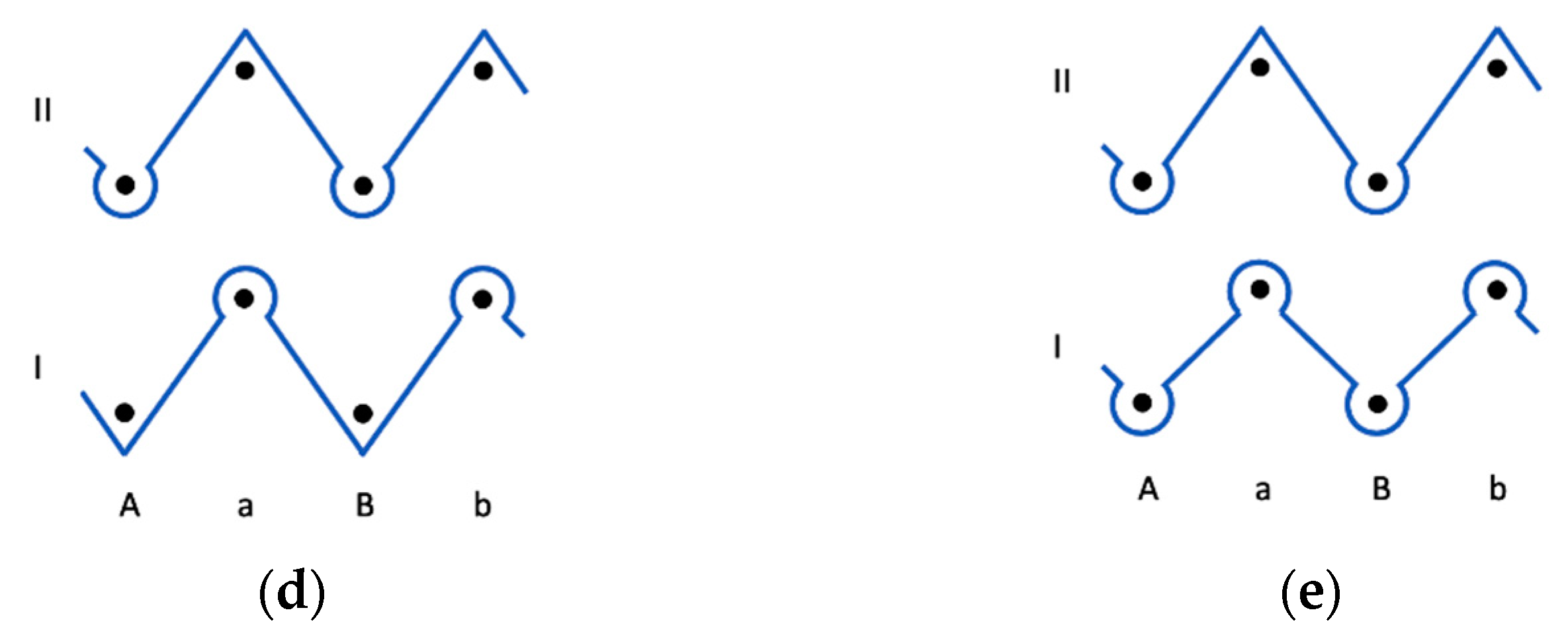
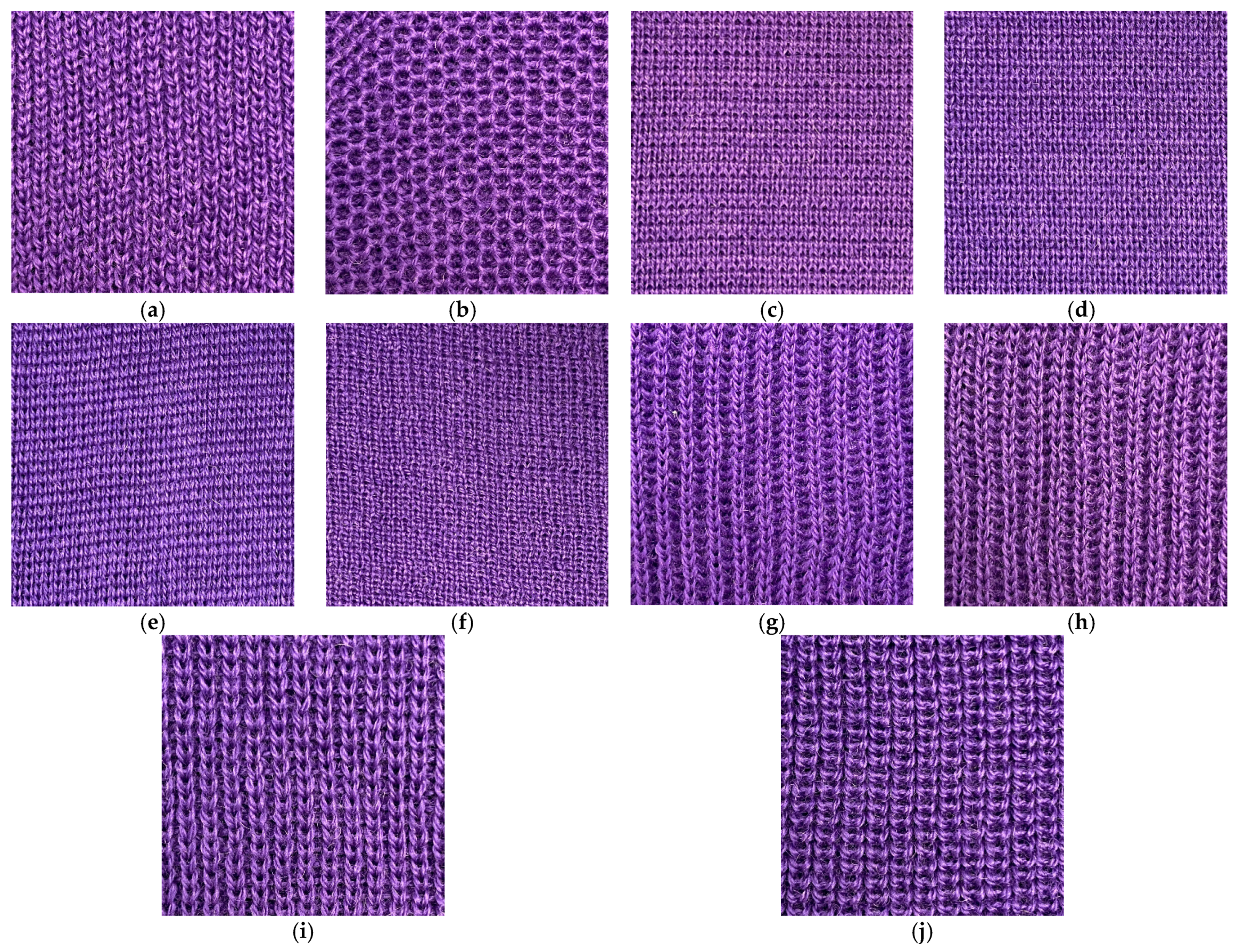
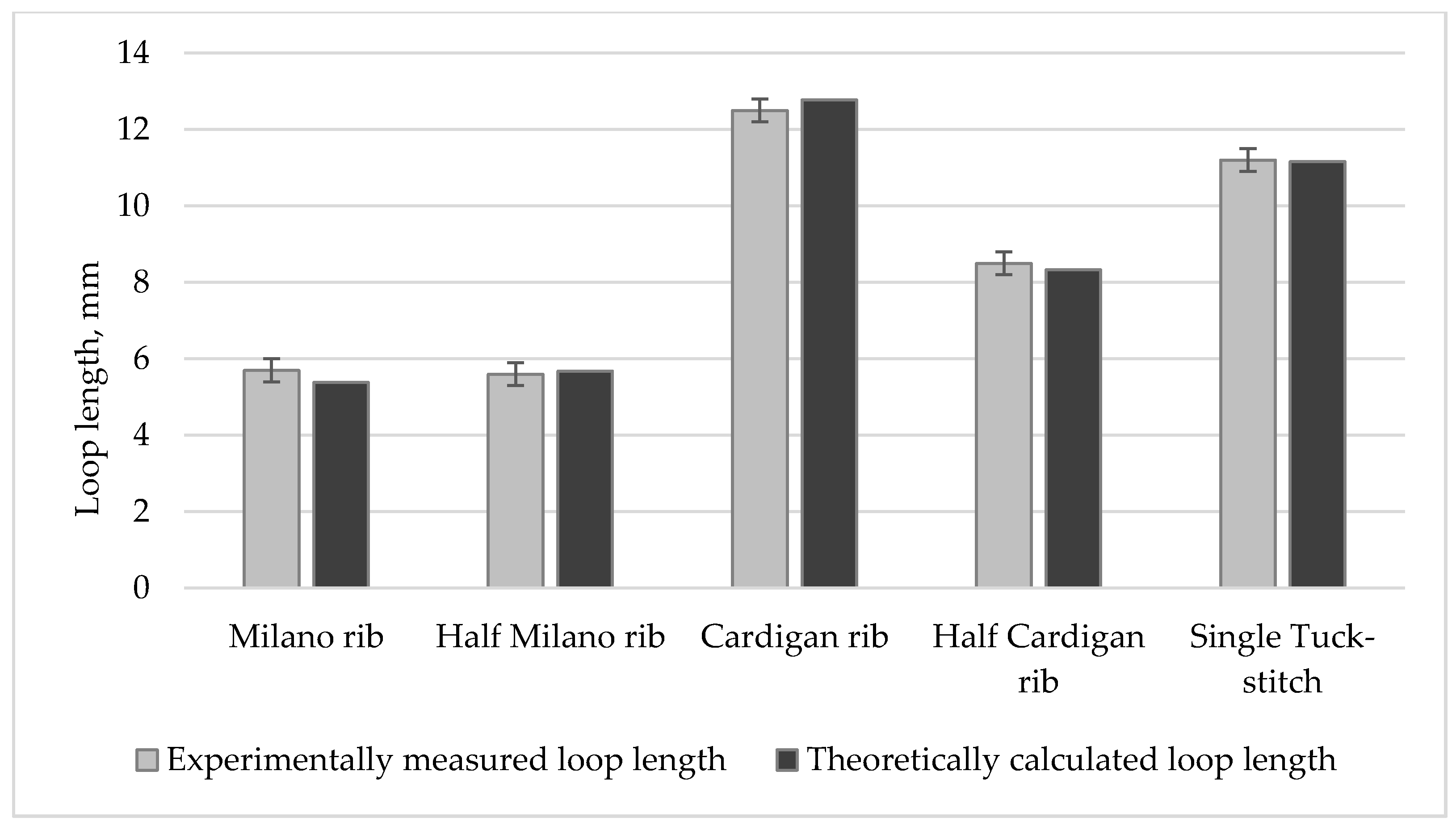
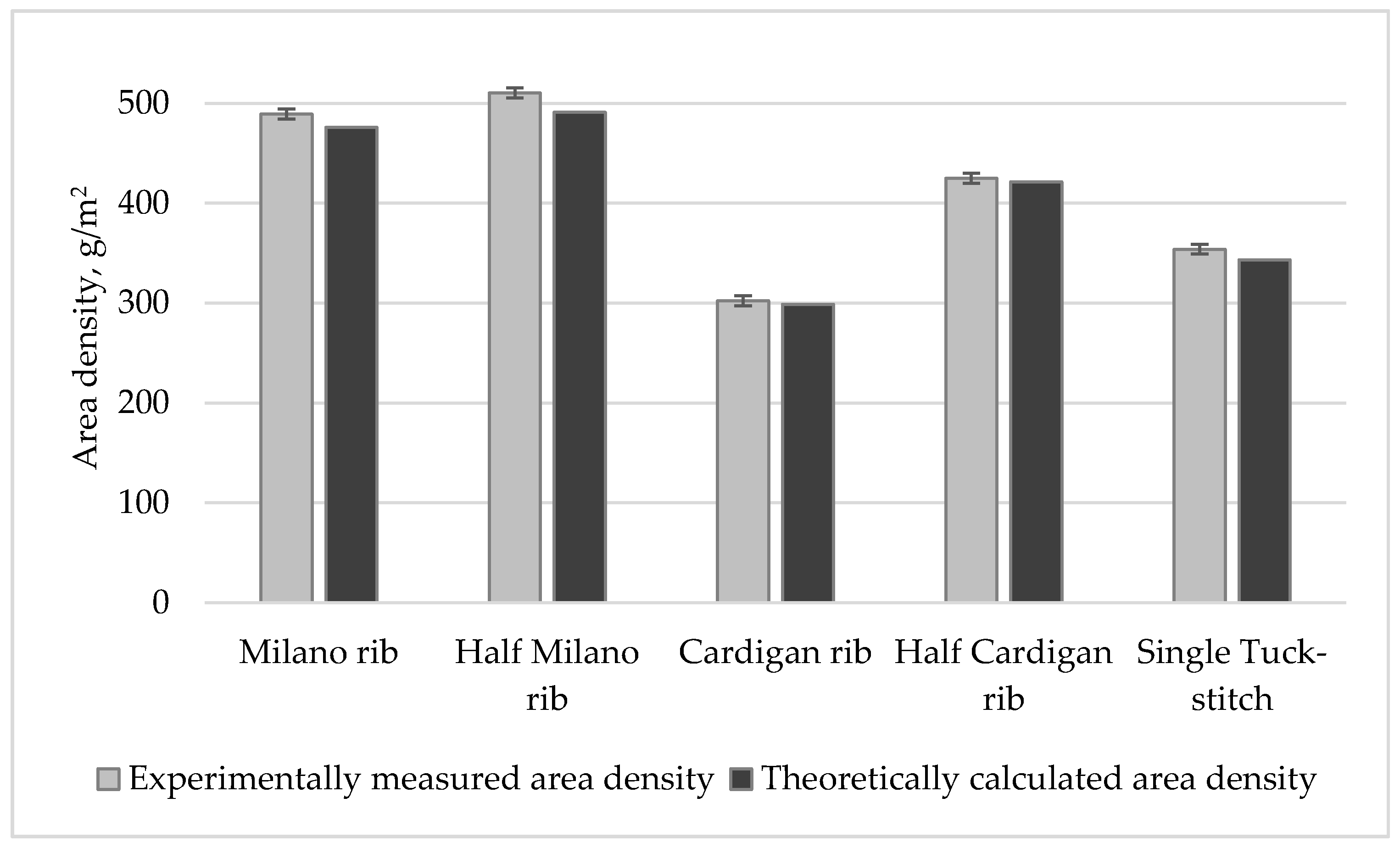
| Pattern | Yarn Diameter d, mm | Wale Density Pw, cm−1 | Course Density Pc, cm−1 | Wale Spacing A, mm | Course Spacing B, mm | Loop Length l, mm | Area Density M, g/m2 |
|---|---|---|---|---|---|---|---|
| Milano rib | 0.4 | 6.5 ± 0.2 | 8.5 ± 0.2 | 1.54 | 1.18 | 5.7 ± 0.2 | 489.2 ± 5 |
| Half-Milano rib | 6.0 ± 0.2 | 6.0 ± 0.1 | 1.67 | 1.67 | 5.6 ± 0.2 | 510.3 ± 5 | |
| Cardigan rib | 4.5 ± 0.2 | 13.0 ± 0.3 | 2.22 | 0.77 | 12.5 ± 0.3 | 302.4 ± 4 | |
| Half-cardigan rib | 7.0 ± 0.2 | 12.0 ± 0.2 | 1.43 | 0.83 | 8.5 ± 0.2 | 424.8 ± 5 | |
| Single tuck stitch | 5.0 ± 0.2 | 15.5 ± 0.3 | 2.00 | 0.65 | 11.2 ± 0.3 | 353.9 ± 4 |
| Pattern | Number of One-Needle-Bar Needle Loops Nls | Number of Two-Needle-Bar Needle Loops Nld | Number of One-Needle-Bar Tucks Loops Nlst | Number of Two-Needle-Bar Tucks Nldt | Number of Horizontal Floats Nlh | Number of Rib Floats Nlr | |||
|---|---|---|---|---|---|---|---|---|---|
| Loop/tuck/float index | I = 1 | I = 3 | I = 1 | I = 2 | I = 1 | I = 2 | I = 1 | I = 2 | I = 1 |
| Milano rib | 2 | - | 2 | - | - | - | - | 2 | 2 |
| Half-Milano rib | 1 | - | 1 | 1 | - | - | - | 1 | 2 |
| Cardigan rib | - | - | - | 2 | - | - | 2 | - | - |
| Half-cardigan rib | - | - | 2 | 1 | - | - | 1 | - | 2 |
| Single tuck stitch | 2 | 2 | - | - | 2 | 2 | - | - | - |
| Pattern | One-Bar Needle Loop ls, mm | Two-Bars Needle Loop ld, mm | One-Bar Tuck lst, mm | Two-Bar Tuck ldt, mm | Horizontal Float lh, mm | Rib Float lr, mm | |||
|---|---|---|---|---|---|---|---|---|---|
| Loop/tuck/float index | I = 1 | I = 3 | I = 1 | I = 2 | I = 1 | I = 2 | I = 1 | I = 2 | I = 1 |
| Milano rib | 3.4 | - | 3.6 | - | - | - | - | 1.84 | 1.93 |
| Half-Milano rib | 2.77 | - | 3.09 | 5.36 | - | - | - | 1.94 | 1.94 |
| Cardigan rib | - | - | - | 8.58 | - | - | 4.19 | - | - |
| Half-cardigan rib | - | - | 4.41 | 8.46 | - | - | 3.89 | - | 1.92 |
| Single tuck stitch | 3.49 | 8.00 | - | - | 4.20 | 6.53 | - | - | - |
| Pattern | Yarn Length in the Pattern Repeat LY, mm | Average Loop Length in the Pattern Repeat , mm | Relative Error between Theoretical and Experimental Values, % |
|---|---|---|---|
| Milano rib | 21.53 | 5.38 | 5.58 |
| Half-Milano rib | 17.04 | 5.68 | 2.42 |
| Cardigan rib | 25.53 | 12.77 | 2.12 |
| Half-cardigan rib | 24.98 | 8.33 | 2.06 |
| Single tuck stitch | 44.62 | 11.16 | 0.39 |
| Pattern | Theoretically Calculated Area Density M, g/m2 | Relative Error between Theoretical and Experimental Values, % |
|---|---|---|
| Milano rib | 475.77 | 2.75 |
| Half-Milano rib | 490.88 | 3.80 |
| Cardigan rib | 298.70 | 1.23 |
| Half-cardigan rib | 421.27 | 0.82 |
| Single tuck stitch | 343.27 | 3.00 |
Publisher’s Note: MDPI stays neutral with regard to jurisdictional claims in published maps and institutional affiliations. |
© 2021 by the authors. Licensee MDPI, Basel, Switzerland. This article is an open access article distributed under the terms and conditions of the Creative Commons Attribution (CC BY) license (https://creativecommons.org/licenses/by/4.0/).
Share and Cite
Arbataitis, E.; Mikucioniene, D.; Ielina, T.; Halavska, L. Flexible Theoretical Calculation of Loop Length and Area Density of Weft-Knitted Structures: Part II. Materials 2021, 14, 4988. https://doi.org/10.3390/ma14174988
Arbataitis E, Mikucioniene D, Ielina T, Halavska L. Flexible Theoretical Calculation of Loop Length and Area Density of Weft-Knitted Structures: Part II. Materials. 2021; 14(17):4988. https://doi.org/10.3390/ma14174988
Chicago/Turabian StyleArbataitis, Edgaras, Daiva Mikucioniene, Tetiana Ielina, and Liudmyla Halavska. 2021. "Flexible Theoretical Calculation of Loop Length and Area Density of Weft-Knitted Structures: Part II" Materials 14, no. 17: 4988. https://doi.org/10.3390/ma14174988
APA StyleArbataitis, E., Mikucioniene, D., Ielina, T., & Halavska, L. (2021). Flexible Theoretical Calculation of Loop Length and Area Density of Weft-Knitted Structures: Part II. Materials, 14(17), 4988. https://doi.org/10.3390/ma14174988







